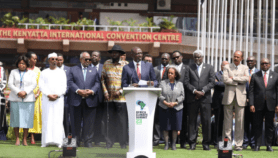By: Smriti Mallapaty
Send to a friend
The details you provide on this page will not be used to send unsolicited email, and will not be sold to a 3rd party. See privacy policy.
[KATHMANDU] The Himalayan countries of Nepal and Bhutan will, in 2013, have two permanent air monitoring observatories set up by the International Centre for Integrated Mountain Development (ICIMOD) as part of a programme to reduce black carbon and other short-lived climate-forcing pollutants (SLCPs).
There has been increasing international attention on SLCPs – small particles and gases like black carbon, methane, and ozone – because of their warming effect on climate. Acting in decades – rather than the centuries taken by greenhouse gases like carbon di-oxide – SLCPs negatively impact human health and agricultural output.
The Climate and Clean Air Coalition, launched by the United Nations Environment Programme in 2011 to reduce SLCPs, has now grown to 33 member-countries.
SPEED READ
- Nepal and Bhutan will begin monitoring short-lived climate-forcing pollutants (SLCPs) in 2013.
- Two new observatories will help quantify emissions and track their sources.
- The aim is to mitigate health, climate and economic impacts of SLCPs
"Some of the most important gaps (in atmospheric monitoring) are in the middle hill areas of the central and eastern Himalayas, in Nepal, Sikkim and Bhutan," explained Arnico Panday, lead atmospheric scientist at ICIMOD.
Panday said there is "very little ongoing monitoring" between the Indian Institute of Technology Kanpur’s station, at 120 metres above sea level, and an observatory at the base of Mount Everest at 5,079 metres.
Data gathered from the two new observatories will help quantify emissions and track their geographic source. They are designed to function as education centres capable of enhancing technical expertise in the region.
ICIMOD has also partnered the Institute for Advanced Sustainability Studies (IASS) in Potsdam, and over a dozen research institutes and universities in the Sustainable Atmosphere for the Kathmandu Valley (SusKat) initiative.
SusKat’s monitoring stations will include one supersite with over 30 advanced instruments and four satellites at major passes leading into the Kathmandu valley. They will measure over 150 parameters on aerosols, gases and meteorology.
This is an "unprecedented campaign" for a city with no currently functioning air quality monitoring station, Maheswar Rupakheti, group leader for SusKat at IASS Potsdam, told SciDev.Net.
Linking science with policy, SusKat will ultimately help identify measures best suited to the local political, socio-economic and physical context with the objective of mitigating health, climate and economic impacts of SLCPs.
It will, for example, help determine if "removing all the motorbikes in the valley will cut down pollution by 5 per cent or 85 per cent," Panday said. "Or it will be possible to say how much of Kathmandu’s air pollution comes from outside the valley."













